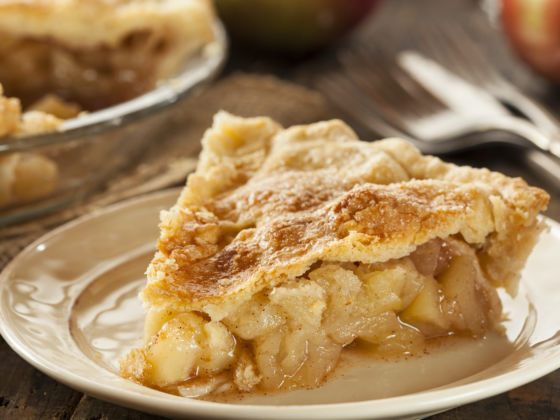Nothing is as American as apple pie, so they say. This flaky, fruit-filled dessert conjures memories of holidays huddled around the dinner table, of steam rising from the lattice crust of a pie on the windowsill, and of generations celebrating and enjoying time together. But apple pie wasn’t invented in the United States. In fact, as is the case for many aspects of American cuisine, the majority of its ingredients hail from abroad.


The Most American Thing About Apple Pie Is Its Global Origin Story
“To be American as apple pie means to be immigrant and imported,” says food writer Robin Caldwell.
Start with the ubiquitous apple, which food historians and scientists believe comes from Central Asia in what is today the Tian Shan forest in Kazakhstan. Wild apples were domesticated there and spread along the Silk Road to Europe. The apple evolved along the Silk Road and in Europe before making it to England and then America via the New World’s early colonists. The only apple indigenous to North America is the sour and small crabapple, which doesn’t fit in well with desserts. Sweet apples have found a second home in the US; it produces the most apples in the world, right after China.
Sugar plays a role in the story of apple pie too, of course: Sugarcane originally comes from Polynesia, and over hundreds of years made its way to Southeast Asia, Persia, the Mediterranean, southern Europe, South America, North America, and the Caribbean. Sugar became a major crop in the Americas during centuries of trade and colonialism. Today, most of the world’s sugar comes from Brazil, China, and India.
You can’t have an apple pie without cinnamon either. There are two common types of cinnamon, Cinnamomum verum and Cinnamomum cassia. The former comes from a tree native to Sri Lanka and the latter from the bark of a tree native to Indonesia and southern China. Once this spice spread to the rest of the world, it became beloved by both the ancient Egyptians and Romans. Today, most cinnamon comes from India, China, Vietnam, and Sri Lanka.
The aromatic spice nutmeg, another classic apple pie ingredient, has a similarly interesting origin story. Nutmeg originally comes from Indonesia, on the island of Banda, one of the so-called “spice islands.” The Dutch colonized the island in the early 1600s and disenfranchised the indigenous residents for hundreds of years, using the raw ingredients on the islands to fuel the spice trade. The Netherlands didn’t leave the region until after World War II. Today, Indonesia is still the top producer of nutmeg, and grows about half of the world’s supply. Sri Lanka, India, and Singapore also grow the valuable spice. The Dutch, however, still have a hand in the nutmeg trade, and continue to be a major exporter.
As for the combination of the above ingredients into a recipe for apple pie, well, that’s not from the US either. According to Caldwell, “Apple pie came to the continent with the British; [it] is British in origin.” In England, the first apple pies emerged in the in the 1300s, and were baked in a crust called a “coffin.” Meanwhile, the Dutch were already making a type of lattice-crust apple pie in the early 1500s.
Finally, there’s the common serving suggestion for classic apple pie: à la mode, which is French for “in the fashion of,” but in the context of pie means with ice cream. Ice cream goes back thousands of years to China, spread to Europe, and then the US. Americans have heartily adopted ice cream — on pie and otherwise.
Maybe apple pie’s well-traveled origin story is the lesson to take away. With its imported roots, apple pie can symbolize the most beautiful thing about America: the melting pot of thousands of cultures that now call the US home. Though the humble yet celebrated apple pie is now a cherished American tradition, we should never forget that its roots extend to China, Italy, England, Sri Lanka, Indonesia, India, Kazakhstan, and beyond.